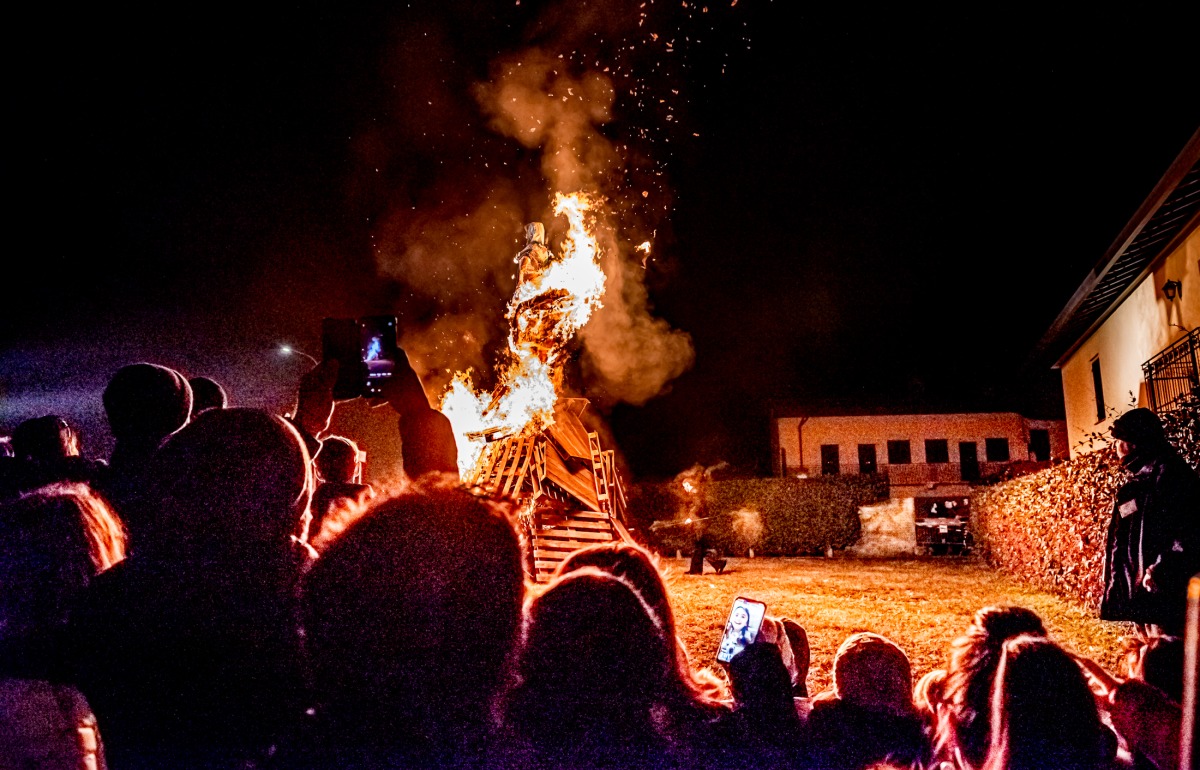In two hundred years doctors will rule the world. Science reigns already. It reigns in the shade maybe – but it reigns. And all science must culminate in the science of healing – not the weak, but the strong. Mankind wants to live… to live.
Joseph Conrad, The Secret Agent (1907), p.263
This article charts the origins and development of what often appears to be a strawman conspiracy theorist over the course of the COVID-19 pandemic, especially through “fact checker” initiatives operating at the behest philanthrocapitalism. This appears to have insulated regulatory agencies long prone to capture from adequate journalistic scrutiny, leading to a groupthink amidst an effective censorship of alternative, and scientifically valid, assessments of the danger posed by COVID-19, and the optimal humanitarian response.
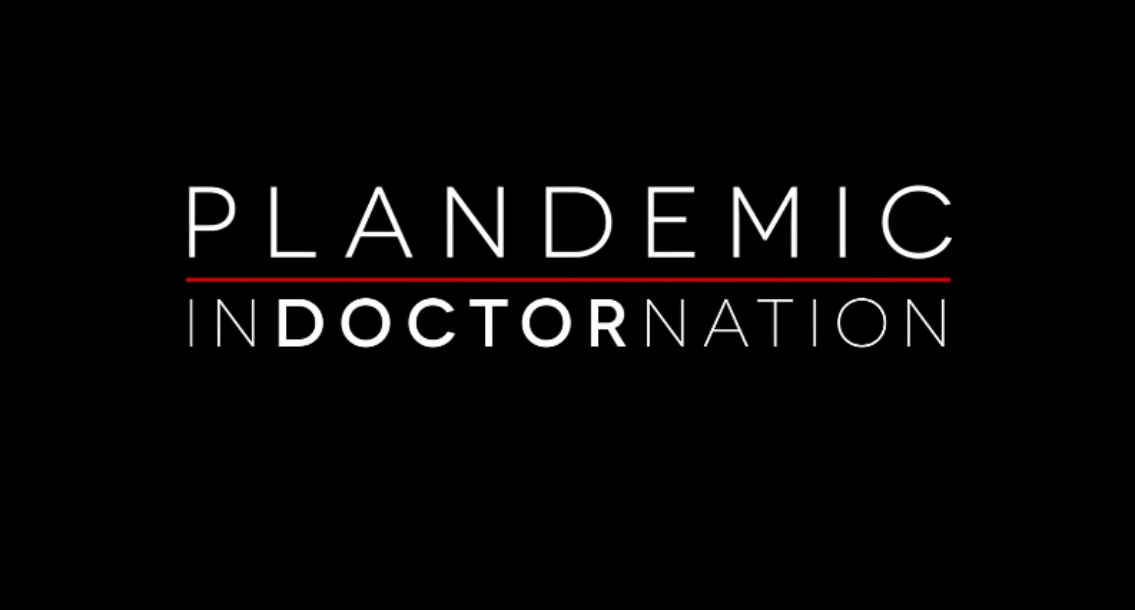
Losing Our Grip?
In May, 2020, veteran Guardian journalist John Naughton explored the origins of Plandemic a “documentary” video ‘featuring Dr Judy Mikovits, a former research scientist and inveterate conspiracy theorist who blames the coronavirus outbreak on big pharma, Bill Gates and the World Health Organization.’ Naughton relates how the video migrated from mainstream social media into the dark recesses of the Internet.
As he put it: ‘The cognitive pathogen had escaped into the wild and was spreading virally.’ Ultimately, the New York Times ‘traced it back to a Facebook page dedicated to QAnon, a rightwing conspiracy theory, which has 25,000 members.’ All this Naughton said: ‘confirms something we’ve known since at least 2016, namely that conspiracy theory sites are the most powerful engines of disinformation around. And when they have a medical conspiracy theory to work with, then they are really in business.’
In May, 2020 The Atlantic’s Jeff Goldburg announced that conspiracy theorists were winning, and that America was ‘losing its grip on Enlightenment values and reality itself.’ Thus a 2014 study estimated that half the American public ‘consistently endorses at least one conspiracy theory,’ a proportion that had risen to 61% by 2019, suggesting the Internet was accelerating the trend. Another survey indicated that 60% of Britons were wedded to a ‘false’ narrative.
Adjudicating on the falseness, or otherwise, of a narrative is not always, however, a straightforward exercise. Indeed, it will be argued that justifiable concerns around recent impugning of expertise have been weaponised to create another layer of disinformation over the course of the COVID-19 pandemic.
The “wild-eyed” conspiracy theorist – often referred to as “members of the tin foil hat brigade” – has become a widely derided figure. This appears to be a belated response to so-called “post-truth” accounts, associated with supporters of Donald Trump in the U.S. and proponents of Brexit in the U.K., dismissive of expertise. This challenged a board consensus around such issues as the importance of mitigating climate change. But in confronting genuine disinformation it appears that many on the left, in particular, failed to interrogate vested interests during the pandemic.
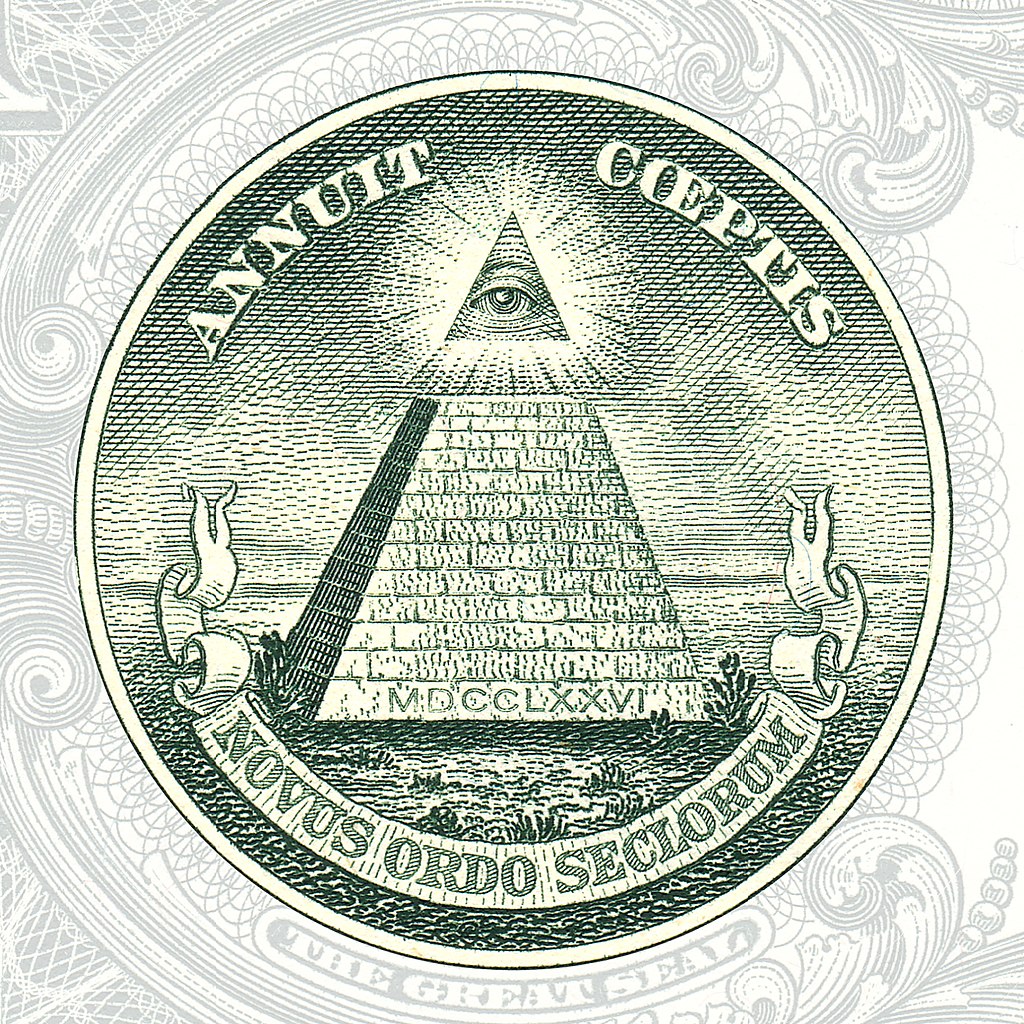
“Totalizing Discourse”
Charles Eisenstein defines conspiracy myths as ‘a totalizing discourse that casts every event into its terms.’ He traces these overarching explanations – relying on observed phenomena only insofar as these fit with a preordained pattern – to the first century Gnostics, who believed that ‘an evil demiurge created the material world out of a pre-existingdivine essence.’
The “totalizing” nature of such an approach has previously been dismissed by Karl Popper since ‘nothing ever comes off exactly as intended.’[i] Oliver and Wood (2014) identify three facets to an approach that has traditionally pointed to Freemasonry –an “illuminati” – Jews and Jesuits, and, in more recent times, intelligence agencies such as the CIA, KGB, MI5 or Mossad:
First, they locate the source of unusual social and political phenomena in unseen, intentional, and malevolent forces. Second, they typically interpret political events in terms of a Manichean struggle between good and evil … Finally, most conspiracy theories suggest that mainstream accounts of political events are a ruse or an attempt to distract the public from a hidden source of power (Fenster 2008)
In her seminal 1951 text The Origins of Totalitarianism, Hannah Arendt identifies such a tendency as a precursor to mob rule, describing how a conspiracy theorist ‘is inclined to seek the real forces of political life in those movements and influences which are hidden from view and work behind the scenes.’[ii]
Yet certain conspiracy theories in our time, such as suggestions the U.S. invaded Iraq in 2003 in order to plunder oil resources rather than decommission weapons of mass destruction, or that the fossil fuel industry deliberately sowed confusion over climate change, remain plausible, even if we lack clear documentary proof.
A problem lies in how individuals with minimal academic attainment treat conspiracies as objective truths rather than conjectures based on circumstantial evidence. The likelihood of a conspiracy is often portrayed as “beyond reasonable doubt”, as opposed to “on the balance of probabilities.” A formally educated observer may be repelled by an insistent approach that does not allow for reasonable doubt.
The intuition relied on by confirmed conspiracy theorists thus generally fails to acknowledge uncertainty, and lacks scientific or historical rigour. Yet these accounts may still occasionally yield insights when empirical methods fall short. After all, suspicions raised by conspiracy theories are often vindicated. Rather than dismissing out of hand such ‘magical thinking’, it is useful to consider these as unproven hypotheses, and not necessarily untrue, simply because an individual is overstating a case.
For example, over the course of the COVID-19 pandemic increasingly persuasive evidence has emerged of a laboratory leak – perhaps from so-called ‘gain of function’ research – giving rise to the pandemic. But in February, 2020 The Lancet published a letter from a number of prominent scientists who ‘strongly condemn conspiracy theories suggesting that COVID-19 does not have a natural origin.’ This had a chilling effect on the scientific debate during the early stages of the pandemic.
Notably also, the ‘father of economics’ Adam Smith opined that ‘People of the same trade seldom meet together, even for merriment and diversion, but the conversation ends in a conspiracy against the public, or in some contrivance to raise prices.’[iii] Smith’s portrayal of commercial calumnies is reflected in a question posed at a medical conference in 2018 by a Goldman Sachs executive: ‘Is curing patients a sustainable business model?’
Previously, a succession of pharmaceutical scandals led Ben Goldacre MBE to take a sympathetic view of so-called “anti-vaxxers”, who are now consistently conflated with “conspiracy theorists”: ‘I think it’s fair to say that anti-vaccine conspiracy theories are a kind of poetic response to regulatory failure in medicine and in the pharmaceutical industry. People know that there is something a little bit wrong here.’
Similarly, Tom Jefferson – editor of the Cochrane Collaboration’s acute respiratory infections – in an interview with Der Spiegel in 2009 in the wake of the Swine Flu pandemic-that-never-was pointed to shadowy pharmaceutical forces: ‘Sometimes you get the feeling that there is a whole industry almost waiting for a pandemic to occur.’
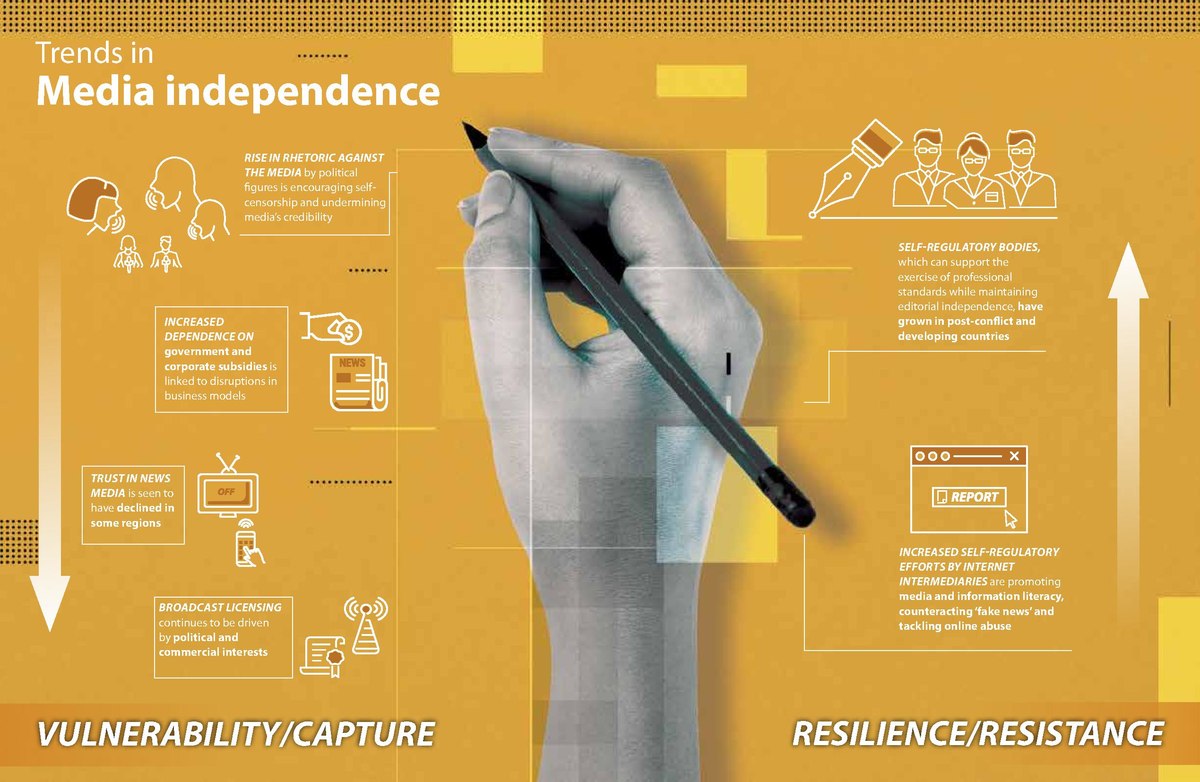
UNESCO’s World Trends Report 2018.
Journalism Under Threat
An assumption of malevolent or self-serving – cui bono? – motivations (particularly concerning a Big Pharma industry with a shameful record of distortion and manipulation) is almost a prerequisite for being an investigative reporter. Stories don’t drop out of the air. Unless a journalist assumes wrongdoing – in essence a conspiracy theory – there would be no reason to begin digging.
The key distinction between genuine journalism and conspiracy theorising is that proponents of the latter tend to blurt out their “findings” without marshalling supporting evidence, with the Internet providing anonymity as required. This, however, makes such accounts easy to ridicule to the detriment of journalism with an evidential basis.
Journalists have long been deflected from investigating large corporations. In a recent memoir the great American journalist Seymour Hersh fumes at how in the late 1970s The New York Times shut down his attempt to investigate corporate America ’when confronted by a gaggle of corporate conmen.’[iv]
This challenge has increased significantly in the wake of the Internet. After the “Original Sin” of free online publication, the number of American journalists fell from 60,000 in 1992 to 40,000 in 2009, a pattern seen across the world. As revenues diminished, workloads increased. Cardiff University researchers recently conducted an analysis of 2,000 U.K. news stories, discovering the average Fleet Street journalist was filing three times as much as in 1985. To put it another way, journalists now have only one-third of the time to do the same job.[v]”
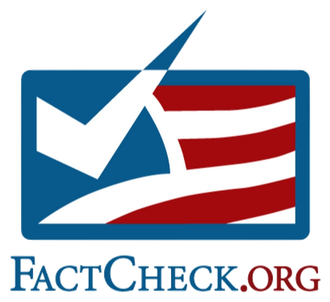
“Fact Checkers”
Over the course of the pandemic a strawman conspiracy theorist appears to have been consciously developed to deter valid journalistic interrogation, in particular, through so-called “fact checking” initiatives. It has reached a point where, as Charles Eisenstein observes: ‘“Conspiracy theory” has become ‘a term of political invective, used to disparage any view that diverges from mainstream beliefs. Basically, any critique of dominant institutions can be smeared as conspiracy theory’
In the absence of adequate journalistic scrutiny during the pandemic corruption has been rife. The executive director of The British Medical Journal Kamran Abbasi described ‘state corruption on a grand scale’ that is ‘harmful to public health’ Abbasi observes how the pandemic ‘has revealed how the medical-political complex can be manipulated in an emergency—a time when it is even more important to safeguard science.’
This also occurred in the context of unregulated social media, where companies set their own rules. In March, 2020, having previously styled itself ‘the free speech-wing of the free-speech party’, Twitter moved to address concerns around conspiracy theories. In future it would be: ‘Broadening our definition of harm to address content that goes directly against guidance from authoritative sources of global and local public health information.’
Nonetheless, free reign was given to “click-bait” alarmists such as Eric Feigle-Ding on Twitter, who saw his following mushroom from just two thousand to almost a quarter of a million. Angela Rasmussen, a Columbia University virologist, identified a pattern: ‘He tweets something sensational and out of context, buries any caveats further down-thread, and watches the clicks and [retweets]roll in.’
Twitter did not act alone in upholding an apparent orthodoxy that often lapsed into an extremism that deterred legitimate questioning. Google took unprecedented steps to erase material violating ‘Community Guidelines’: ‘including content that explicitly disputes the efficacy of global or local health authority recommended guidance on social distancing that may lead others to act against that guidance.’
Initially at least, Facebook adopted a more laissez faire approach, although users who had read, watched or shared ‘false’ coronavirus content received a pop-up alert urging them to go the World Health Organisation’s website. In November, 2021, however, the editors of the British Medical Journal sent an open letter to Facebook in response to “fact checkers” undermining their investigative report into ‘a host of poor clinical trial research practices’ at Pfizer’s original vaccine trial.
Thus, the approach of the social media giants was bolstered by an unprecedented journalistic effort to “factually” repudiate conspiracy theories during the pandemic; notwithstanding how ‘uncontested facts—things that are ascertainable, reproducible, transferable and predictable—tend to be elusive.’
Preparations for the “fact-checking” initiative began in January, 2020 when a global #CoronaVirusFacts Alliance, comprising more than one hundred “factcheckers” around the world, described as ‘the largest collaborative factchecking project ever,’ was launched by the Poynter Institute, ‘when the spread of the virus was restricted to China but already causing rampant misinformation globally.’ It said that the WHO had classified the issue as ‘an infodemic — and the Alliance is on the front lines in the fight against it.’
From March 2020, with the support of these “fact checkers”, outlets such as Reuters responded to an anticipated wave of conspiracy theories, taking particular care to address allegations against Bill Gates. He has been described as ‘the world’s most powerful doctor’ despite not having earned a medical degree due to the Gates Foundations being the second largest funder of the WHO, after China. This included allegations that he had apparently planned the pandemic, and wanted to commit genocide through vaccines.
For example, on May 30, 2020 a BBC article purported to defuse claims the pandemic was ‘a cover for a plan to implant trackable microchips and that the Microsoft co-founder Bill Gates is behind it’; although it acknowledged Gates had said that ‘eventually “we will have some digital certificates” which would be used to show who’d recovered, been tested and ultimately who received a vaccine,’ and also referenced ‘a study, funded by the Gates Foundation, into a technology that could store someone’s vaccine records in a special ink administered at the same time as an injection.’
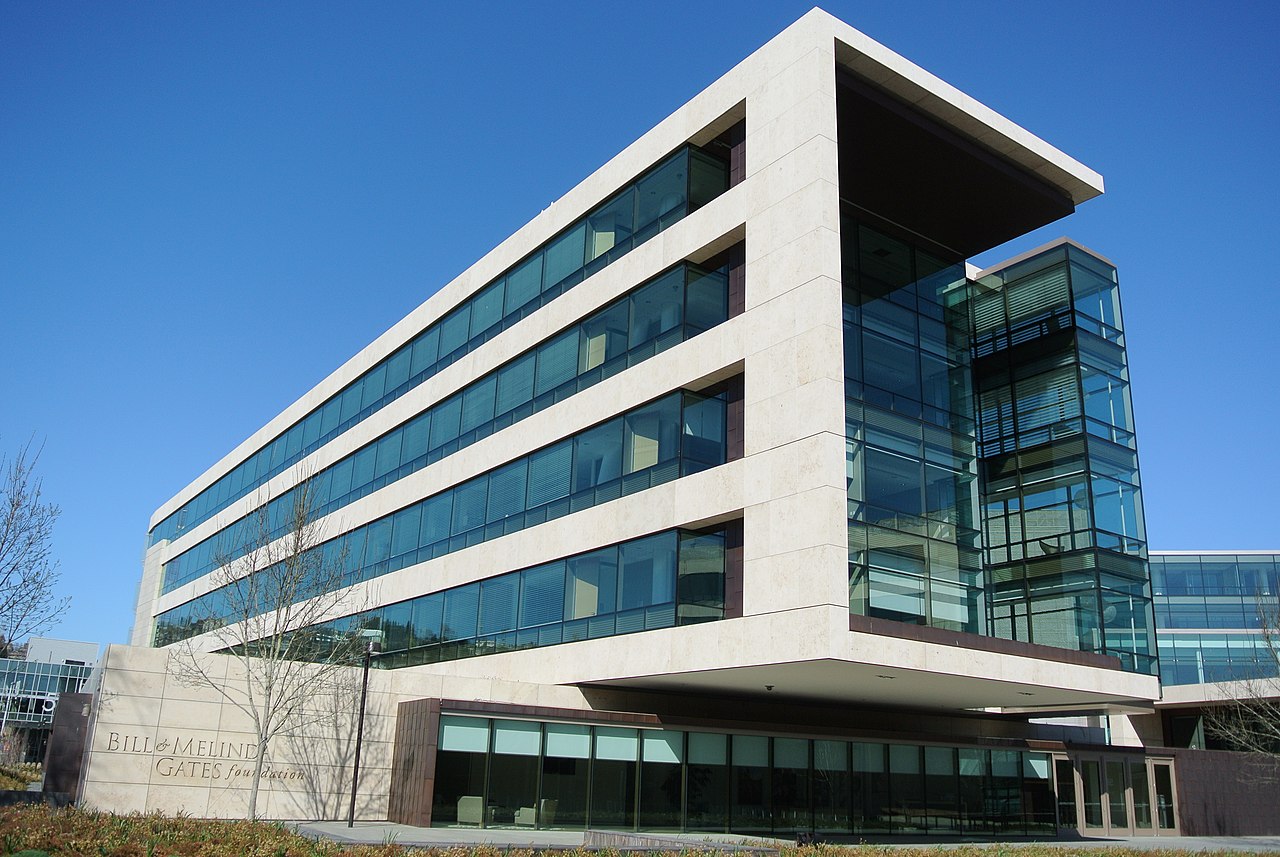
Front building of the Bill and Melinda Gates Foundation in Seattle.
Gates Foundation
When it came to outlandish conspiracy theories around COVID-19 all roads led to Bill Gates and his $47 billion philanthropic Bill and Melinda Gates Foundation – besides a personal fortune of $115 billion, and growing, as of October 2020.
For many of world’s population under stay-at-home orders the pandemic was viewed through a digital prism – often at a remove from morbidity or mortality itself. At that stage, Gates’s 2014 Ted Talk ‘The Next Outbreak. We’re not ready’ seemed almost prophetic.
He opined: ‘If anything kills over ten million people in the next few decades it is most likely to be a highly infectious virus rather than a war.’ The failure of Western governments to prepare for such an eventuality seemed to have been laid bare – in particular the Presidential administration of Donald Trump, who according to a Cornell University study ‘was likely th\\e largest driver of the COVID-19 misinformation “infodemic.”’
Gates’s Ted Talk, however, failed to discuss the false alarm of the Swine Flu Pandemic, when the WHO estimated that between 2.0 and 7.4 million could die, assuming the outbreak was relatively mild. This proved a wild exaggeration as less than 300,000 were estimated to have died globally, with Western governments stockpiling millions of dollars’ worth of GlaxoSmithKlein’s Pandemrix vaccine, which brought an elevated risk of narcolepsy.
Gates’s main reference point appears to have been the Spanish Influenza (H1N1) outbreak of 1918 – the Ur-pandemic of modern times – that led to up to fifty million deaths, many of them young men in their prime, at a point when the global population was approximately two billion. In contrast, the infectivity and severity of SARS-CoV-2 ‘are well within the range described by respiratory viral pandemics of the last few centuries (where the 1918–20 influenza is the clear outlier).’
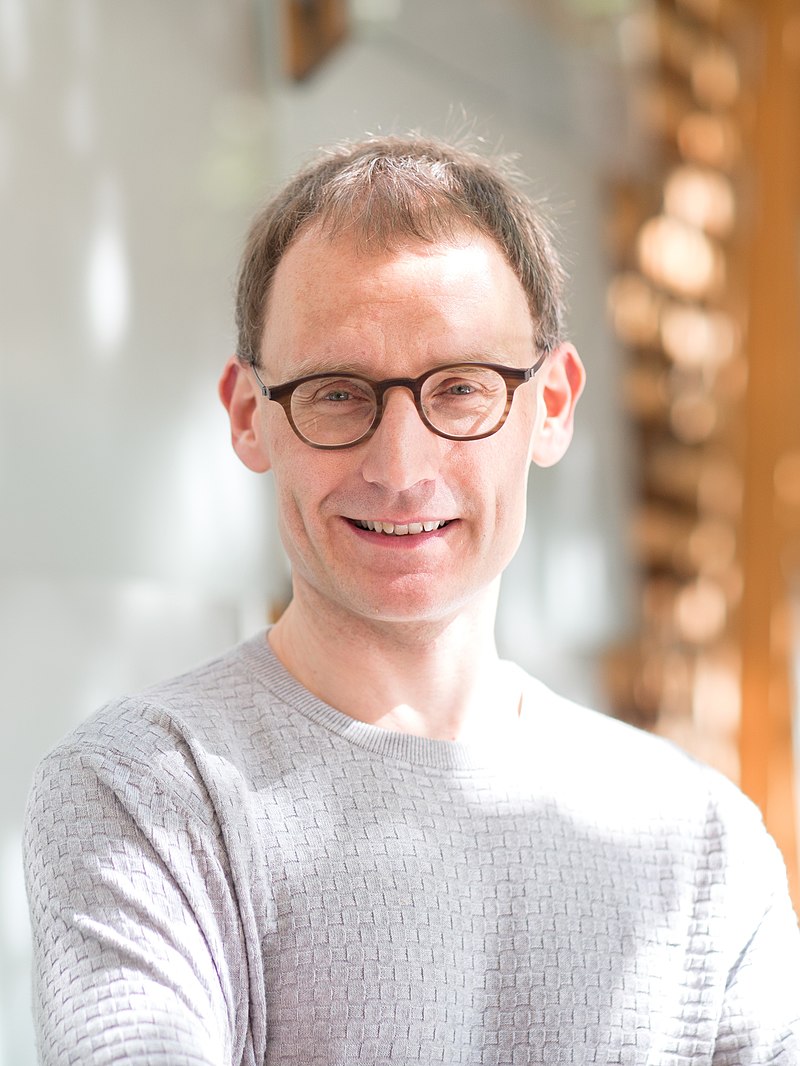
Neil Ferguson
“Scientific Groupthink”
In March, 2020, Imperial College’s Neil Ferguson told the New York Times the ‘best case outcome’ for the U.S. was a death toll of 1.1 million, rising to 2.2 million in a worst case scenario, a projection that has proved wildly inaccurate. Yet, alternative, and scientifically valid, assessments of the danger posed by COVID-19, and the optimal humanitarian response to the challenge were virtually ignored in legacy media at the time. Thus, an Oxford University paper, which included Sunetra Gupta as an author, countered what the New York Times described as the ‘gold standard’ Imperial modelling underestimated immunity from prior coronavirus infections and posited a far lower infection fatality rate.
But in March, 2020, the Financial Times warned that Gupta’s group’s modelling was ‘controversial and its assumptions have been contested by other scientists.’ Implicitly, the Financial Times was accepting the “gold standard” Imperial paper.
Moreover, in November, 2020 an article in the Scientific American describes how Stefan Baral, an epidemiologist and associate professor at Johns Hopkins Center for Global Health, wrote a letter about the potential harms of lockdowns which was rejected from more than ten scientific journals (and six newspapers) in April, 2020. Baral recalls, ‘it was the first time in my career that I could not get a piece placed anywhere.’
The article also recalled that, ‘highly anticipated results of the only randomized controlled trial of mask wearing and COVID-19 infection went unpublished for months.’ The authors concluded that the ‘net effect of academic bullying and ad hominem attacks has been the creation and maintenance of “groupthink”—a problem that carries its own deadly consequences.’
In the absence of access to authoritative, diverging scientific accounts, opposition to lockdowns could easily be dismissed as being the preserve of conspiracy theorist cranks associated with “anti-vaxxers” and even a “far-right” fringe.
“Screen New Deal”
Apart from offering pharmaceutical companies the huge financial incentive – grasped within open arms – of developing a vaccine for universal application, lockdowns and social distancing measures also brought soaring profits for major technology corporations. Moreover, restrictions provided a testing ground for the Gates Foundation’s long advocacy of technological approaches in education.
In May, 2020 Naomi Klein identified collusion between state and Big Tech interests in what she described as ‘A Screen New Deal.’ She referred to New York Governor Mario Cuomo’s courting of Google and the Gates Foundation: ‘Calling Gates a “visionary,” Cuomo said the pandemic has created “a moment in history when we can actually incorporate and advance [Gates’s] ideas … all these buildings, all these physical classrooms — why with all the technology you have?” he asked, apparently rhetorically.’
Remote learning technology permitted extended school closures around the world, despite the chance of death from COVID-19 being ‘incredibly rare’ among children. Research now suggests many students made little or no progress while learning from home, and that learning loss was most pronounced among disadvantaged students. As a consequence, up to 20,000 children in the U.K. went missing from school rolls during the pandemic. Nor is it apparent that teachers faced any greater risk compared to the wider population in fulfilling classroom teaching.
Media Funding
Popular consent on a global scale for lockdowns, particularly from those identifying on the left, seems to have been manufactured through vast ‘philanthropic’ funding of journalism, in particular of publications associated with progressive outlooks.
By June 2020, the Gates Foundation contributed $250 million to journalism, which according to Tim Schwab in The Columbia Journalism Review, ‘appears to have helped foster an increasingly friendly media environment for the world’s most visible charity.’
A theme of ‘we are in this together’ inhibited criticism and enquiry. This quiescence has been criticized by the Greek socialist Panagiotis Sotiris who wrote: ‘What is missing here is something that used to be one of the main traits of the radical left, namely, an insistence that science and technology are not neutral.’
Tim Schwab calculates that $250 million had been devoted to journalism by the Gates Foundation for the six months up to June, 2020,. Recipients included BBC, NBC, Al-Jazeera, ProPublica, National Journal, The Guardian, Univision, Medium, The Financial Times, The Atlantic, The Texas Tribune, Gannett, Washington Monthly, Le Monde, and the Center for Investigative Reporting, as well as the BBC’s Media Action and The New York Times’ Neediest Cases Fund.
Schwab adds: ‘In some cases, recipients say they distributed part of the funding as subgrants to other journalistic organizations—which makes it difficult to see the full picture of Gates’s funding into the fourth estate.’
As a result, he says:
During the pandemic, news outlets have widely looked to Bill Gates as a public health expert on covid—even though Gates has no medical training and is not a public official. PolitiFact and USA Today (run by the Poynter Institute and Gannett, respectively—both of which have received funds from the Gates Foundation) have even used their fact-checking platforms to defend Gates from “false conspiracy theories” and “misinformation,” like the idea that the foundation has financial investments in companies developing covid vaccines and therapies. In fact, the foundation’s website and most recent tax forms clearly show investments in such companies, including Gilead and CureVac.
A colonial legacy, a distrust of a mercantilist pharmaceutical industry and erosion of democracy jeopardise preserving population health through vaccination write MSF's Francoise Duroch & Duncan McLeanhttps://t.co/brW41215h9@broadsheet_ie @BallouxFrancois @FrancoiseDuroch
— CassandraVoices (@VoicesCassandra) January 16, 2021
‘Undermining Scientific Creativity’
The Gates Foundation’s pivotal role in funding global health has long raised concerns. In 2008, Dr. Arata Kochi, the former head of WHO’s malaria programme argued the Gates Foundation was undermining scientific creativity in a way that ‘could have implicitly dangerous consequences on the policymaking process in world health.’ He worried that Gates-funded institutions – including Imperial College London (MRC Centre for Global Infectious Disease Analysis) – were adopting ‘a uniform framework approved by the Foundation,’ leading to homogeneity of thinking: ‘Gates has created a ‘cartel,’ with research leaders linked so closely that each has a vested interest to safeguard the work of others. The result is that obtaining an independent review of scientific evidence (…) is becoming increasingly difficult.’
GAVI, the Vaccine Alliance, is the most obvious example of the Gates Foundation’s engagement. GAVI has successfully immunized large numbers of children, but been criticized by other NGOs for inadequate funding of health system strengthening.
One of GAVI’s senior representatives reported that Bill Gates often told him in private conversations ‘that he is vehemently ‘against’ health systems (…) he basically said it is a complete waste of money, that there is no evidence that it works, so I will not see a dollar or cent of my money go to the strengthening of health systems.’
As of 2017 only 10.6 percent (US$862.5 million) of GAVI’s total commitments between 2000 and 2013 had been dedicated to health system strengthening, whereas more than 78.6 percent (US$6,405.4 million) have been used for vaccine support. Doctors Without Borders (MSF) states that, while GAVI has helped to lower prices of new and underused vaccines for eligible countries, the cost to fully immunize a child was 68-times more expensive in 2014 than it was in 2001.
According to long-time Gates critic James Love, Gates ‘uses his philanthropy to advance a pro-patent agenda on pharmaceutical drugs, even in countries that are really poor.’

Safe Treatment?
This article makes no bold claims regarding the efficacy of any treatments, but the overwhelmingly negative reaction of legacy media to research pointing to the efficacy of the off-patent drug Ivermectin suggests that vested pharmaceutical interests wished to undermine public confidence in any scientific arguments regarding its efficacy.
In June, 2020, a laboratory study demonstrated it was ‘an inhibitor of the causative virus’ (Caly, 2020). Later, a Systematic Review, Meta-analysis that included twenty-four randomized controlled trials said: ‘Moderate-certainty evidence finds that large reductions in COVID-19 deaths are possible using ivermectin.’
In a predictable example of “fact-checking” where an outlandish claim is used to discredit a compelling hypothesis, the Poynter Institute quoted a social media post ‘rating’ the claim that Ivermectin basically ‘basically obliterates’ as ‘false.’
The Guardian’s dedication to discrediting the meta-analysis also suggested vested interests were at work, and contrasts with a failure to report on the British Medical Journal’s account of a whistle blower alleging serious data integrity issues during Pfizer’s vaccine trial.
It should hardly be controversial – let alone dismissed as a conspiracy theory – to argue that the weight of evidence points to a ‘Gates-Approach’ lying behind ongoing adoption by most Western governments of unprecedented suppression measures in support of universal vaccination – notwithstanding potential treatment alternatives – leading to the introduction of vaccine passports, as Gates “predicted” in April, 2020. This also occurred alongside a familiar ‘rhetoric supportive of ‘holistic’ health systems.’
It is now clear that consent for lockdowns, especially in the Anglophone world, was manufactured through wildly inaccurate epidemiological assessments of an infection fatality rate of 0.9% in the notorious Imperial College paper. This estimate has since been adjusted to 0.2% (available on the WHO website), a figure which Joffe argues is likely ‘a large over-estimate.’
It is also clear that globally mortality statistics for COVID-19 have been systematically exaggerated. This manipulation can be traced to a WHO document from April, 2020 entitled ‘International Guidelines for Certification and Classification (Coding) of COVID-19 as Cause of Death’. It set out strict rules for the registration of COVID-19 deaths, which differ fundamentally from registration for other causes. The guidelines define a COVID-19 mortality as ‘a death resulting from a clinically compatible illness, in a probable or confirmed COVID-19 case, unless there is a clear alternative cause of death that cannot be related to COVID disease (e.g. trauma).’
It is revealingly that in a country such as Ireland since the pandemic began the mean age of death from COVID-19 has been eighty years of age (eight-two being the median age), just two years younger than the average age of death, and that level of mortality through the years 2018-2020 (2018: 31,116; 2019: 31,134; 2020: 31,765) show little difference.[vi]
For most people COVID-19 is a virus that poses little danger. Prior to the arrival of a vaccine, a U.K. study from October, 2020 found 76.5% of a random sample who tested positive reported no symptoms, and 86.1% reported none specific to COVID-19. Moreover, an article from Peter Doshi in the British Medical Journal in September, 2020, stated: ‘At least six studies have reported T cell reactivity against SARS-CoV-2 in 20% to 50% of people with no known exposure to the virus’; apparently vindicating Sunetra Gupta’s “controversial” paper, over which the Financial Times cast doubt.
It should not be controversial to argue that morbidity and mortality from COVID-19 ought to have been weighed against the global impact of lockdowns. On that score, a new paper jointly by authored by researchers from Johns Hopkins University in the US, Lund University, in Sweden and the Centre for Political Studies, in Denmark concluded that lockdowns in Europe and the US decreased COVID-19 mortality by a measly 0.2% on average.
Richard Kearney's Touch asserts the importance of physical contant in healing. Crippling anxiety in the wake of COVID-19 indicates a need for medicine to reform.https://t.co/4SLoA3YFaK@broadsheet_ie @BowesChay @indepdubnrth @corourke91 @itsmybike @NMcDevitt @iHealthReform
— CassandraVoices (@VoicesCassandra) December 1, 2021
Conclusions
A “totalizing” discourse of a COVID-19 conspiracy theory identifies a preordained plan being set in motion by malicious actors, wherein the pandemic culminates in a dangerous vaccine being foisted on a brainwashed population. This might lead to an assumption that such vaccines invariably give rise to severe adverse reactions that are systematically covered up. Such an account does not demand evidence as events are simply unfolding “as planned.”
In reality, however, events rarely follow a preordained pattern, and even in circumstances of regulatory capture state agencies are never entirely bereft of integrity. Moreover, such accounts divert attention from probing interrogation of the efficacy of vaccines and the desirability of universal uptake of a medication that does not block transmission, especially one rushed to the market, and which may cause unforeseen adverse reactions.
It is also apparent that public perception of the efficacy of vaccines has been distorted by the media’s reporting of relative risk reduction, as opposed to absolute risk reduction, which is just 0·84% for the Pfizer–BioNTech vaccines.
Moreover, importantly, in January, 2021, Peter Doshi and Donald Light in the Scientific American objected to the undermining of ‘the scientific integrity of the double-blinded clinical trial the company—and other companies—have been conducting, before statistically valid information can be gathered on how effectively the vaccines prevent hospitalizations, intensive care admissions or deaths.’
This came after Pfizer pleaded an “ethical responsibility” to unblind its trial and offer the vaccine to those who received a placebo. The authors argue that ‘there was another way to make an unapproved vaccine available to those who need it without undermining a trial. It’s called “expanded access.” Expanded access enables any clinician to apply on behalf of their patient to the FDA for a drug or vaccine not yet approved. The FDA almost always approves it quickly.’
In terms of any actual conspiracy or contrivance to raise prices along the lines of tendencies that Adam Smith pointed to among gentlemen of commerce, the role played by Bill Gates has been, doubtless, more complex than many conspiracy theorists allow for. However, in circumstances where a billionaire with a history of monopolistic aspirations promotes an agenda aligning with his financial interests it should come as no surprise that colourful theories abound; especially with many journalists seemingly inhibited from enquiring into his Foundation’s activities.
Indeed, ironically, the aforementioned Guardian journalist John Naughton recently described Gates while Microsoft CEO as having acted like ‘a mogul who is incredulous that the government would dare to obstruct his route to world domination.’ Does such a leopard ever change his spots?
Sadly, the amplification of the outlandish claims of conspiracy theorists by so-called “fact checkers” could be causing reputational damage to genuine expertise, and allow demagogues reliant on angry mobs to say: “I told you so.” The propagandist role of “fact checkers” has undermined genuine investigative reporting, much of which already occurs on the margins.
In the early stages of the pandemic especially, difficulties in reporting were compounded by deficits in scientific understanding among overworked journalists in precarious employment, who were encouraged to justify unprecedented lockdowns as a form of social solidarity. The assumption that by “following the science” a journalist is adequately performing his or her role is a dangerous fallacy, which does not take account of how diverging scientific arguments may be concealed.
In the absence of sufficient independent journalism, and amidst censorship of alternative scientific opinion, troubling questions remain unanswered as the pandemic draws to a close. Perhaps we will never know the full story. Nonetheless, it is vital that adequate cost-benefit analyses (including with access to full trial data) are conducted on all pharmaceutical and non-pharmaceutical interventions in future.
Feature Image (c) Daniele Idini: The Burning of “the Witch of Winter” in Cardano al Campo, Lombardy, Italy.
We are an independent media platform dependent on readers’ support. You can make a one-off contribution via Buy Me a Coffee or better still on an ongoing basis through Patreon. Any amount you can afford is really appreciated.
[i][i]Karl Popper (1972). Conjectures and Refutations, 4th ed. London: Routledge Kegan Paul. pp. 123–125.
[ii] Hannah Arendt (1951) The Origins of Totalitarianism, 1951, p.140
[iii] Adam Smith, The Wealth of Nations, book 1, chapter 10, par. 2).
[iv] Seymour Hersh, Reporter, 2018, p.247.
[v] Rusbridger, Alan, The Remaking of Journalism and Why it Matters, 2018, p.163-181
[vi] Worldometre attributes 1,736 deaths to COVID-19 by December 31st, 2020.

